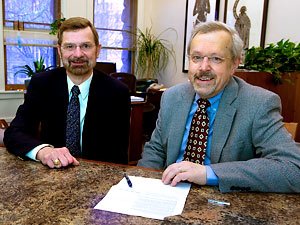The honor of a lifetime

Faculty members Don Truhlar and David Kohlstedt join National Academy of Sciences
By Deane Morrison
If the U.S. Senate is, as it has been called, "the most exclusive club in the world," the National Academy of Sciences must be the second. It elects members from the cream of the the country's scientific crop, and this year it added two from the University of Minnesota: Don Truhlar, chemistry, and David Kohlstedt, geology and geophysics.
In receiving an honor many scientists consider next to the Nobel Prize, neither Truhlar nor Kohlstedt would take full credit. Instead, both insisted that their accomplishments were possible only because of the caliber of the graduate students they worked with.
Whatever the secret of their success, here's a glimpse at their contributions to science.
Doping the Earth
In making ceramic materials, adding trace amounts of impurities a process called doping can vastly improve a material's performance. The Earth, says Kohlstedt, does the same thing with the rock lying far below the surface. The impurity it adds to the rock? Plain old water.
The hydrogen in water "has a huge influence, especially on the strength of the rock and how easily it can be made to flow, even while it remains solid," states Kohlstedt, an I.T. Distinguished Professor and head of the University's Winchell School of Earth Sciences. "The hydrogen weakens the rock."
Lying above weakened rock, plates of the Earth's crust and uppermost mantle can move around relatively freely. Called plate tectonics, movements of these surface plates open up seams where heat from the mantle can escape, usually through the formation of volcanoes or fissures. While volcanoes can cause a lot of damage, plate tectonics allows the Earth to reshape its crust a little at a time, avoiding global disaster.
Not so on Venus. Kohlstedt has argued that no plate tectonic movements occur on our sister planet because it is too hot to keep water in either its rocks or its atmosphere. Consequently, heat from the interior builds up in the strong, dry surface rocks until they break up and catastrophically flip over.
And it's largely atoms of hydrogen the tiniest of atoms that stand between Earth and a similar fate, Kohlstedt has found.
Consider what's happening in the Mid-Atlantic Ridge, a chain of undersea mountains being pushed up from underneath by upwardly mobile molten rock. For a long time, geophysicists wondered how deep melted rock could rise the 60-90 miles to Earth's surface quickly enough to forestall the catastrophic overturn of crust seen on Venus.
In his laboratory, Kohlstedt subjected rocks to the high temperatures and pressures of Earth's mantle. He discovered that as these extreme conditions deform the upper mantle, upward-pointing ribbons, or channels, of partially melted rock form in it.
"They act like superhighways," he says. "Molten rock is less dense than solid rock, so melt moves rapidly through these channels."
The channels form in part due to the presence of hydrogen, which lowers the melting point of the rock by several hundred degrees, Kohlstedt notes. Once melt begins to form in the deforming mantle rock, it segregates into melt-rich channels that become fluid avenues for transporting heat.
Kohlstedt is this year's winner of the Murchison Medal of the Geological Society of London, which lauds him and his research group as, among other things, without doubt the world leaders in framing our modern understanding of the spectacular effects that water and melt have on the [ease of flow] of rocks in the lower crust and upper mantle.
It all computes
At first glance, Truhlar's work may seem inaccessibly complex: finding practical methods of using quantum mechanics to compute the rates at which chemical reactions occur. But the importance of his work becomes clear from a consideration of what happens when a drug enters a person's body.
"A drug must arrive at the site of biological action to perform its intended task," says Truhlar, a Regents Professor. "But a drug may react with other things in the body and get destroyed, and so become unable to do its job. Or, it may react in such a way as to produce toxic side effects." Being able to predict such chemical reactions beforehand can help scientists design drugs to maximize their effectiveness while minimizing side effects.
The beauty of Truhlar's work is that his methods work for scientists studying all kinds of chemical reactions, including those that can't be run in a laboratory. For example, chemical reactions between pollutants and ozone high in the atmosphere occur at temperatures too low to work with directly. But by applying Truhlar's theories, scientists can extrapolate to conditions in the upper atmosphere and calculate the reaction rates.
"Don is developing methods that can be applied to problems we don't even know about today," says Jeffrey Roberts, chemistry department chair. "He is one of the most cited chemists in the world."
As director of the University's Supercomputing Institute from 1988 to 2006, Truhlar made its resources available to a broad group of faculty, including those who use high-performance computing as an adjunct to their work rather than as its focus. An associate editor of the world's premier chemical journal, he has won the American Chemical Society awards for computational chemistry and physical chemistry and the Schroedinger Medal of the World Association of Theoretical and Computational Chemistry.
